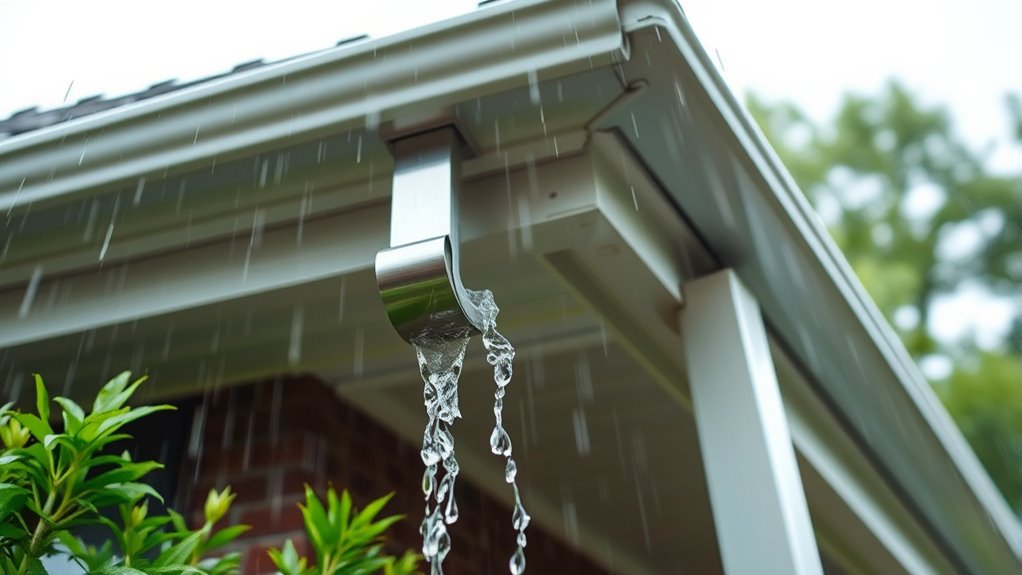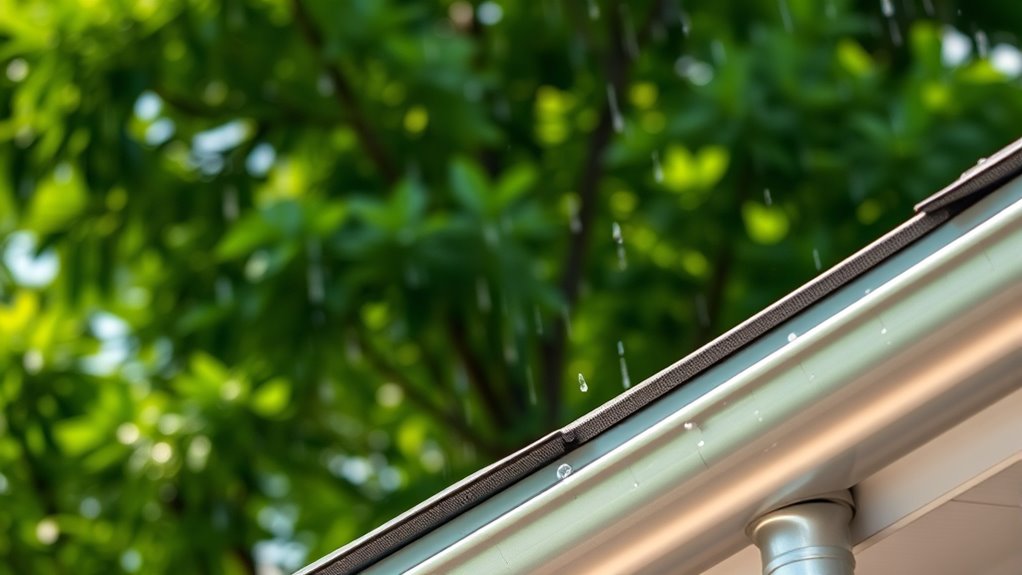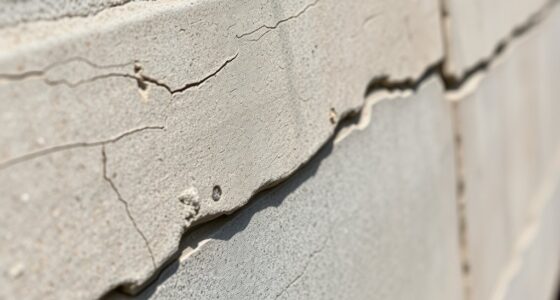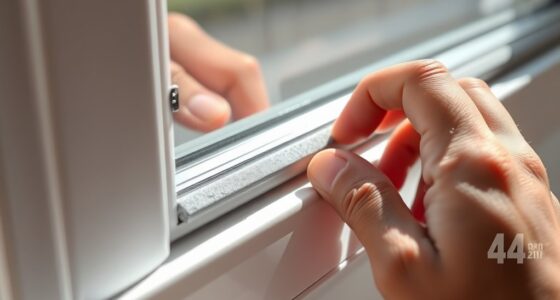To prevent gutter overflow disasters, regularly clean and inspect your gutters for debris like leaves and twigs, especially after storms. Make sure they’re properly installed with a slight pitch toward the downspouts and that water flows at least 3-4 feet away from your foundation. Upgrade to larger gutters or add extra downspouts if you experience frequent overflow. Proper maintenance and installation are crucial; keep going to learn more about safeguarding your home from water damage.
Key Takeaways
- Regularly inspect and clean gutters to prevent debris buildup that causes clogs and overflow.
- Ensure proper gutter pitch and downspout placement to facilitate efficient water flow away from the home.
- Upgrade to larger gutters or add more downspouts if frequent overflow occurs during heavy rains.
- Install gutter guards to reduce debris accumulation and simplify maintenance.
- Promptly repair or replace damaged gutters to maintain optimal water channeling and prevent disaster.

Gutters are vital for protecting your home from water damage by directing rainwater away from the roof and foundation. When functioning properly, they prevent water from seeping into your walls, damaging your siding, and pooling around your basement or crawl space. Without effective gutters, heavy rains can cause erosion, leaks, and even costly structural issues. That’s why maintaining your gutters is essential for preserving your home’s integrity over time.
A key aspect of preventing overflow disasters is ensuring your gutters are clear of debris. Leaves, twigs, dirt, and other obstructions can quickly clog the system, causing water to spill over the edges rather than flow smoothly through the downspouts. Regularly inspecting and cleaning your gutters, especially during fall and after storms, helps maintain proper drainage. Using a sturdy ladder and wearing gloves, you can safely remove accumulated debris, or consider hiring a professional if your gutters are difficult to access or if you’re uncomfortable working at heights.
Proper installation is equally important in avoiding overflow issues. Your gutters should be pitched correctly, with a slight slope toward the downspouts, to guarantee water moves efficiently. If the slope is uneven, water can pool and overflow. Additionally, downspouts need to be positioned to direct water at least three to four feet away from your home’s foundation. Extending downspouts with splash blocks or flexible extensions can help prevent water from pooling near your basement or crawl space, reducing the risk of flooding or foundation damage.
Another common problem is gutter capacity. If your gutters are too narrow or too small for your home’s rainfall volume, they can overflow during heavy storms. Consider upgrading to larger gutters if you notice frequent overflow, or install additional downspouts to distribute water more evenly. Installing gutter guards can also reduce debris buildup, minimizing clogs and overflow risks, but keep in mind that guards still require maintenance.
Finally, keep an eye out for signs of damage, such as sagging, rust, or leaks. Damaged gutters lose their ability to channel water properly and need repair or replacement. Addressing these issues promptly can save you money and prevent water-related damage to your home. Additionally, understanding the importance of proper gutter capacity helps homeowners choose the right system for their needs, ensuring effective water management during heavy rainfall. By staying vigilant with cleaning, ensuring proper installation, and upgrading when necessary, you can effectively prevent overflow disasters and protect your home from costly water damage.
Frequently Asked Questions
How Often Should Gutters Be Professionally Inspected?
You should have your gutters professionally inspected at least twice a year, typically in spring and fall. During these inspections, a professional can identify potential blockages, leaks, or damage that you might miss. If you have trees nearby, consider more frequent checkups, especially after storms or heavy winds. Regular inspections help prevent overflow, water damage, and costly repairs, keeping your home safe and well-maintained.
Can Gutter Guards Completely Prevent Clogs?
Gutter guards can markedly reduce clogs, but they aren’t foolproof. Think of them as a gentle gatekeeper, keeping larger debris out while allowing water to flow smoothly. Regular maintenance and cleaning are still essential to catch tiny particles that slip through. By combining guards with routine inspections, you create a resilient system that safeguards your home from potential water damage, ensuring your gutters stay clear and functional.
What’s the Best Type of Gutter Material for Heavy Rainfall?
If you’re dealing with heavy rainfall, aluminum gutters are your best choice. They’re durable, lightweight, and resistant to rust, making them ideal for handling large volumes of water. You can also opt for steel gutters if you want extra strength, but they’re heavier and may corrode faster without proper coating. Regular maintenance helps guarantee your gutters perform well, regardless of the material you choose.
How Do I Fix a Leaking Gutter Joint?
To fix a leaking gutter joint, first clean out the area thoroughly to remove debris. Then, apply a high-quality gutter sealant or waterproof caulk along the joint, making sure to fill any gaps completely. If the joint is damaged beyond repair, you may need to replace the section with a new gutter piece. Tighten any loose brackets or screws to ensure proper alignment and prevent future leaks.
Are There Eco-Friendly Gutter Cleaning Options?
Nearly 70% of homeowners now prefer eco-friendly gutter cleaning options. You can choose biodegradable cleaning solutions, like vinegar and baking soda, which effectively remove debris without harming the environment. Additionally, using a leaf blower or a gentle rainwater rinse can minimize chemical use. These methods protect local water sources and wildlife, making your gutter maintenance more sustainable. Embrace eco-friendly practices to keep your gutters clean and the planet healthier.
Conclusion
Now that you know the ins and outs of gutters, you’re better equipped to prevent overflow disasters before they happen. Regular maintenance, timely cleaning, and proper installation are your best defenses. Remember, an ounce of prevention is worth a pound of cure, so don’t wait until trouble knocks on your door. Stay proactive, keep your gutters in check, and you’ll avoid the headache of water damage down the line. After all, a stitch in time saves nine.









